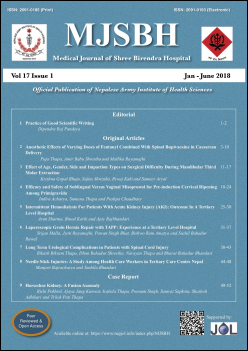Horseshoe Kidney: A Fusion Anomaly
DOI:
https://doi.org/10.3126/mjsbh.v17i1.19585Abstract
A horseshoe shaped kidney was found in an approximately 35 years old female cadaver during routine dissection at anatomy lab of our department. Further careful dissection was done in situ and ureter and related blood vessels were identified and painted for identification.
The isthmus connecting the inferior poles of the kidneys was ventral to the great abdominal vessels. There were multiple vessels supplying the horseshoe kidney on either side, the ureteric drainage pattern was also not symmetrical.
Horseshoe kidney is the commonest renal fusion anomaly found in 1 in 400-600 individuals, it is twice common in males than females. It occurs when kidneys are pushed too close to each other during their relative ascent through arterial fork of umbilical arteries in fetal life.
Horseshoe kidney is associated with increased risk of renal calculus. Surgical division of the isthmus improves the renal function even in the absence of any pathology. Due to vascular variations, Angiographyor CT scanning with vascular reconstruction is very helpful when planning surgery on horseshoe kidney.
Downloads
859
556




